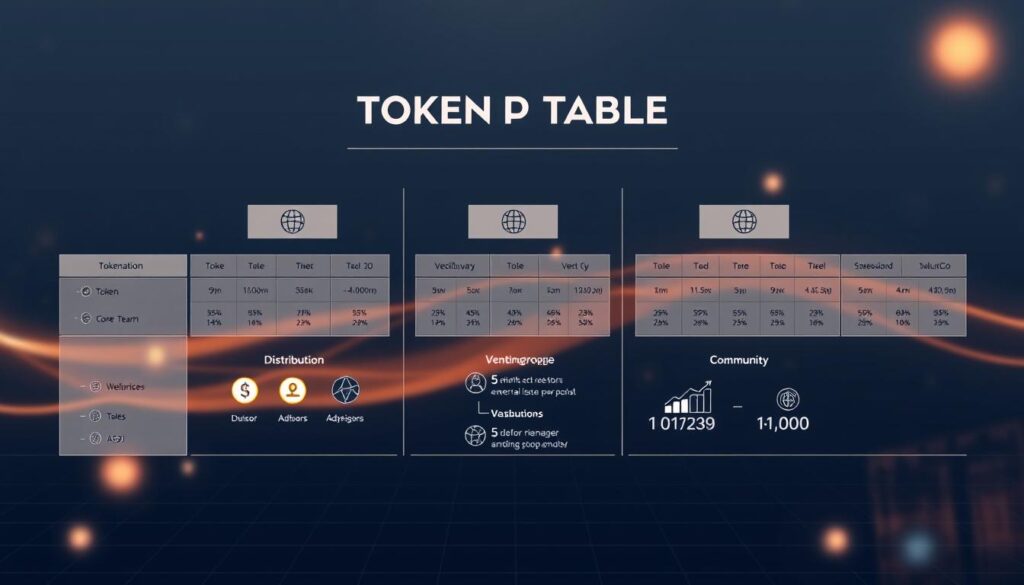Now Reading: Effective AI Crypto Token Distribution and Airdrop Strategies
- 01
Effective AI Crypto Token Distribution and Airdrop Strategies
Effective AI Crypto Token Distribution and Airdrop Strategies

Free token drops can jumpstart networks, reward early users, and grow loyal communities. Well-designed plans turn simple giveaways into long-term value drivers.
Real-world examples show the scale: Uniswap’s 400 UNI per prior user, Stellar’s $125M XLM campaign, and 2023 drops like Jito, Arbitrum, and Blur that reached hundreds of millions in initial value. These headlines prove what careful planning can achieve.
Unpaid distributions include staking rewards, community pools, and validator incentives. They sit beside cap table allocations as part of a broader go-to-market playbook. Done right, they kickstart network effects and align participation with product goals.
Risks cover scams, tax rules in the United States, and vanity metrics from poor targeting. Later sections will cover objectives, cap table design, anti-sybil measures, wallet targeting, vesting, legal readiness, and analytics. For more on data-driven drops, see how projects use data to build.
Key Takeaways
- Targeted freebies can bootstrap growth and align incentives with product use.
- Successful campaigns like Uniswap and Arbitrum show large-scale impact.
- Combine cap table design with staking and validator rewards for balance.
- Plan for tax, legal, and anti-sybil controls, especially in the U.S.
- Measure KPIs and match incentives to verifiable user value for lasting engagement.
Understanding unpaid token distributions and why they matter for future crypto projects
Projects frequently rely on unpaid grants to align early behavior with long-term goals. These grants include founder, team, and advisor allocations inside Token Incentive Schemes, plus external programs like staking, bounties, validators, and community pools.
How airdrops fit into broader token allocation models
Airdrops are one tool among many in a full token distribution plan. They sit alongside DAO treasury allocations and ongoing reward systems that fund growth and security.
When free tokens drive real adoption versus vanity metrics
Free units move the needle when tied to meaningful on-chain actions. Claims alone often inflate numbers but fail to create lasting usage or governance participation.
- Differentiate recipients: internal incentives vs. external community programs.
- Design goals: align grants to cohorts—builders, end users, governance participants—for relevance.
- Legal note: U.S. guidance can treat some free transfers like sales; keep records of pools and legal instruments for compliance and audits.
- Measure impact: track transactions, staking, and governance as proof beyond tokens distributed.
AI crypto token distribution and airdrop strategies
Segmenting wallets by observable behaviors helps teams reward the most relevant contributors. Begin with clear objectives, then map cohorts so rewards match impact. This reduces waste and improves uptake.
Mapping segmentation to cohorts
Cluster wallets by actions: DEX volume, staking history, bridging events, and governance votes. Use automated models to score activity, then vet high scores with manual checks.
Aligning objectives with mechanics
Decide whether the aim is awareness, better decentralization, or increased utility. Match grant size and vesting to each goal so recipients become long-term users.
Balancing reach, security, and compliance
Blend on-chain filters with minimal off-chain signals like region or language while keeping privacy top of mind. Add anomaly detection to flag duplicate wallets and timing spikes that suggest botting.
- Checklist: define cohorts, document compliance assumptions, test automated flows, and audit inclusion logic.
- Trade-offs: seed broadly for network effects or concentrate on high-value contributors for immediate ecosystem gains.
Define clear objectives before you distribute a single token
First, set clear, measurable outcomes so every grant ties back to product goals. Start with three KPI families that map to launch phases. That focus prevents wasted allocations and makes later analysis simple.
Awareness, user acquisition, and community health KPIs
Awareness metrics track impressions, mentions, and referral traffic.
Acquisition measures claim-to-activation rates and first meaningful transaction.
Community health covers retention, governance turnout, and repeat engagement.
Conversion goals across time: snapshot claims vs. ongoing tasks
Distinguish one-off snapshot claims from progressive task funnels that reward continued use over time. Progressive paths convert casual claimers into active users by tying rewards to milestones like staking, bridging, or liquidity provision.
Readiness checklist before any launch:
- Clear objectives and cohort definitions
- Incentive budgets and vesting rules
- Risk controls and anti-gaming guardrails
- Quantified targets for eligible wallets, expected claims, and activation thresholds
| KPI Family | Primary Metric | Target Number | Sample Guardrail |
|---|---|---|---|
| Awareness | Impressions / Mentions | 500k impressions | Cap paid referrals per user |
| Acquisition | Claim-to-activation rate | 30% activation | Decay rewards for repeat low-impact claims |
| Community Health | 30-day retention / governance turnout | 20% retention; 5% vote turnout | Tiered vesting for early recipients |
| Conversion over Time | Milestone completions (staking, bridging) | 10k milestone completions | Per-wallet caps; progressive rewards |
Finally, use cohort-specific messaging to cut drop-off between claim and the first meaningful transaction. Track cohorts over time to confirm that initial recipients become durable community members.
Designing your Token Cap Table and pools for collaborators and community
A robust cap table begins with explicit allotments for collaborators and a visible path to community governance. Define founders, team members, advisors, and the DAO treasury so everyone sees how value flows over time.

Founders, team, advisors: structuring Token Incentive Schemes
Mirror Web2 option plans by formalizing Token Incentive Scheme documents that describe eligibility, vesting schedules, cliffs, and good/bad leaver rules.
Execute employment, advisory, and Token Option Agreements to make allocations legally clear and enforceable.
DAO treasury and community pool governance for distributions
Route community allocations to an on-chain DAO treasury and set proposal thresholds, quorum, and payout rules.
Sequence distributions so collaborators receive allocations from the token company while community funds move via DAO votes.
- Align pool sizing with runway and adoption goals to limit dilution for investors and members.
- Publish allotments, vesting calendars, and DAO decision frameworks to build trust.
- Enforce lock-ups and vesting in smart contracts to reduce discretionary risk.
| Pool | Purpose | Governance |
|---|---|---|
| Founders & Team | Long-term incentives | Company contract + vesting |
| Advisors | Consulting and introductions | Advisory agreements with cliffs |
| Community / DAO | Grants, growth, governance | On-chain proposals and quorum rules |
Choosing the right airdrop type for your project and audience
Picking an appropriate free-tokens format starts with who you want to reach. Define target groups, desired actions, and the value per recipient before finalizing mechanics.
Standard, holder, exclusive, bounty, and referral options
Standard drops suit broad awareness goals. Use them for reach while capping per-wallet claims to limit abuse.
Holder offers reward loyalty. Grant to on-chain holders to boost retention and align long-term interest.
Exclusive grants deepen ties with early contributors, power users, or governance delegates.
Bounty programs pay for meaningful work—content, audits, or bug reports—tiered by complexity.
Referral models can scale growth, but apply quality checks to avoid inorganic sign-ups. BNB-style referrals show the potential and the pitfalls.
Forks and ecosystem expansion
Fork airdrops can extend reach across chains, as Bitcoin Cash demonstrated after a protocol split. Align eligibility rules to protect holders and remain compliant.
- Calibrate free tokens so supply does not overwhelm market signals.
- Predefine verification steps to reduce confusion and abuse.
- Communicate plainly to lower support volume and meet U.S. expectations for clear disclosures.
| Type | Best for | Risk control |
|---|---|---|
| Standard | Broad awareness | Caps, KYC optional |
| Holder | Loyalty | On-chain proof |
| Bounty / Referral | Contributions / Growth | Tiering, fraud checks |
Execution methods: snapshot, manual, and automated airdrops
Choosing an execution path sets how precise the rollout will be and how much operational work you accept.
Snapshots lock eligibility at a specific block height for deterministic results. They make a clear allowlist from on-chain history. Use snapshots when fairness and repeatability matter.
Manual sends give curated control. Teams can vet recipient addresses and remove high-risk entries. This approach is labor intensive but reduces edge-case errors.

Security trade-offs and smart contract testing
Automated claim contracts scale well but raise security demands. Run unit, fuzz, and integration tests. Hire audits before mainnet.
Protect against re-entrancy, overflow, and signature replay. Validate Merkle proofs when using claim flows. Publish immutable values like block height and Merkle root for transparency.
Scaling without spamming the network
Stage rollouts to avoid gas spikes. Batch transfers and open timed claim windows. Verify addresses against deny-lists to cut malicious participation.
| Method | Best for | Primary trade-off |
|---|---|---|
| Snapshot | Deterministic eligibility | Requires clear block height, limited flexibility |
| Manual | Curated recipients | High labor, low scale |
| Automated (claim) | Repeatable, scalable | Higher contract risk, needs audits |
Operational notes: build tamper-evident allowlists from snapshot data. Publish verification tools and keep an incident response plan with pause controls. For examples of well-run drops, see best airdrops to claim.
Task and reward design that discourages sybil abuse and spam
Designing tasks and payouts with layered checks reduces fake accounts and low-quality noise. Build a system that rewards clear value while blocking common farming tactics.
Weighted bounties based on contribution impact
Weight rewards by measurable impact—bug severity, code merged, or content reach. Higher-impact work earns larger payouts while low-effort tasks get modest tokens.
Referral mechanics that prioritize quality over volume
Require conversion thresholds, periodic re-verification, and KYB checks for partners. Use declining rewards for repeated low-value referrals to cut mercenary behavior.
Anti-bot and anti-farm safeguards
- Blend on-chain signals with off-chain checks to set eligibility.
- Cap per user and add diminishing returns for repeat claims.
- Detect anomalies: clustered creation times, address reuse, or unusual activity spikes.
- Consider minimum staking or time-locked claims to align long-term participation.
| Measure | Purpose | Result |
|---|---|---|
| Multi-signal checks | Sybil resistance | Fewer fake users |
| Weighted bounties | Quality reward | Higher-value contributions |
| Referral caps | Anti-farming | Improved conversion |
Compliance note: keep public messages documented to avoid turning promotions into regulated sales in the United States. Offer appeals and transparent scoring to build trust.
Community building and social media distribution the right way
Effective community work mixes brief alerts with deep tutorials to turn interest into action.

Channel strategy: X, Telegram, Reddit, YouTube, LinkedIn
Map each platform to a clear role. Use X and Reddit for awareness bursts. Keep Telegram for live support and tight group coordination.
Put long-form explainers and tutorials on YouTube and LinkedIn to guide new participants toward meaningful tasks.
Content formats that convert claimers into active users
Create a ladder of short posts, how-to guides, walkthrough videos, and live AMAs. Start with an announcement, then follow with a step-by-step tutorial to reduce friction.
Collect emails with explicit consent and useful exchanges like guides or access passes. Partner with credible creators and platforms for reach while keeping public disclosures clear.
- Prefer high-signal media placements over spammy posting cadences.
- Standardize scam warnings and brand-safety checks across every group.
- Measure success by post-claim actions: on-chain tasks, session depth, or repeat visits.
| Channel | Main Role | Success Metric |
|---|---|---|
| X | Awareness | Impressions and click-throughs |
| Telegram / Reddit | Activation & support | Claim-to-action rate |
| YouTube / LinkedIn | Education | Tutorial completions and return visits |
| Nurture | Opt-ins and conversion rate |
Wallet targeting and cross-chain reach for new users
Targeted wallet outreach lets teams reach likely adopters with measurable on-chain signals.
Use smart contract filters to find past claimers, stakers, and bridgers from public events. Build eligibility lists from staking transactions, bridge deposits, governance votes, and prior claims so outreach focuses on high-intent addresses.
Target past claimers, stakers, bridgers using on-chain filters
Index multiple blockchain ecosystems to expand cross-chain reach and locate adjacent audiences. Score wallets by asset diversity, transaction history, and protocol mix to prioritize likely adopters.
- Build lists from on-chain events: prior claims, staking txs, bridge deposits, votes.
- Avoid over-targeting the same addresses that show up in many public campaigns to limit fatigue.
- Tailor messages by history—stakers get validator-focused utility; bridgers get cross-chain guides.
- Respect privacy: rely on lawful public data and avoid invasive deanonymization.
Calibrate allocations to wallet quality tiers so tokens reach users who drive activity. Track post-launch asset usage to confirm targeted segments convert into durable engagement. For planning reference on broader approaches, see crypto airdrops 2025.
Vesting, cliffs, and lock-ups to protect token value
Lock-up periods and phased vesting help preserve market confidence while tying team incentives to product milestones. Set clear rules before grants hit the market so schedules are predictable for investors and users.
Use cliffs to prevent immediate liquidations. Typical cliffs run 3–12 months, followed by monthly or quarterly vesting. Founders and advisors often accept 1–2 year lock-ups to show commitment.
Good leavers, bad leavers, and vesting enforcement
Define good vs. bad leaver outcomes in agreements. Stop vesting for departures that violate rules and claw back unvested portions where appropriate.
Document rights for prorated vesting on exits, severance exceptions, and dispute processes to reduce later conflicts.
On-chain vs. off-chain vesting records
On-chain schedules are transparent and automatic via smart contract logic. Off-chain records offer flexibility but depend on legal enforceability.
Consider hybrid models: enforce core lock-ups on-chain while keeping KPI triggers in signed agreements. Publish a public vesting calendar so markets can plan around future unlocks.
- Implement cliffs to align long-term value creation and limit sell pressure.
- Use KPI-based vesting for growth roles to tie token issuance to measurable outcomes.
- Enforce 1–2 year lock-ups for founders/advisors via both contract and agreement.
- Keep full records for compliance and audit trails.
| Aspect | Typical Approach | Benefit |
|---|---|---|
| Cliff | 3–12 months | Stops immediate sales, proves commitment |
| Vesting schedule | Monthly/quarterly over 2–4 years | Predictable supply, reduced volatility |
| Lock-up | Founders/advisors: 1–2 years | Aligns leadership with long-term goals |
| Enforcement | On-chain contracts + legal agreements | Transparency and enforceability |
Monitor unlock schedules well ahead of events. Coordinate communications, exchange listings, and community updates to manage market impact and protect long-term project value.
Staking rewards, validators, and oracles as ongoing distribution
Design ongoing programs so security, liquidity, and participation grow together. Align emissions to measurable protocol work—block production, data validation, and staking commitments.
Drive network effects with proof-of-stake incentives by offering steady rewards to those who lock assets. Locking improves security and creates lending-like supply that can support on-chain markets.
Practical guardrails for sustainable incentives
Set predictable emissions for validators and oracles based on clear contribution metrics. Pair reward rates with caps so inflation stays in check and sell pressure is limited.
- Use slashing and uptime rules to align behavior with reliability.
- Offer delegated staking to widen participation without weakening security assumptions.
- Publish APRs, compounding mechanics, and risk notes so newcomers understand trade-offs.
| Mechanic | Purpose | Design tip |
|---|---|---|
| Staking rewards | Security & liquidity | Predictable schedule; cap emissions |
| Validator/oracle pay | Accurate blocks & data | Metric-based payouts; audits |
| Delegation | Broad access | Lower minimums; clear fees |
Measure how rewards affect governance turnout, retention, and active use. Reassess parameters as the ecosystem matures so incentive design stays aligned with real-world behavior.
Legal and regulatory foundations for the United States
Even well-intended giveaways can trigger securities scrutiny if promoted with profit expectations. In U.S. practice, courts and regulators look beyond labels to facts. If a program ties claims to marketing, anticipated price gains, or investor recruitment, it may be treated as a sale.

When free distributions may still be sales of securities
FinHub commentary warns that public promotions and bounties can create securities risk. Airdrops that reward behavior tied to project success often raise the same tests used for offerings.
Designing publicly promoted campaigns with compliance in mind
Before launch, seek legal review for token classification, offering exemptions, marketing disclosures, and transfer limits. Maintain clear records of pools, vesting, and Token Incentive Schemes to satisfy investor diligence.
- Use careful language in ads; avoid promises about price or returns.
- Apply KYC/AML where required for large or exchange-listed events.
- Update terms and disclosures as guidance and regulations change.
| Jurisdiction | Key Point | Practical Step |
|---|---|---|
| United States | Promotions can create securities liability | Legal opinion; marketing review; KYC as needed |
| Cayman | Sale for consideration differs, but securities tests still apply | Document issuance method; consult local counsel |
| Project Controls | Investor diligence depends on records | Publish vesting schedule; keep pool ledgers |
Security, user safety, and scam prevention in airdrops
User trust hinges on simple security habits that block most phishing attacks. Scammers impersonate high-profile projects on social channels and fake support groups. Always assume a message is hostile until proven genuine.
Private key hygiene and source verification
Never share private keys or seed phrases. Legitimate airdrop offers will never ask for them.
Verify official domains, signed messages, and announcement handles before clicking links. Cross-check contract addresses and chain IDs on block explorers to avoid phishing or address poisoning.
Project due diligence: team, whitepaper, roadmap
Research the team, read the whitepaper, and confirm the roadmap has past delivery. Projects with clear history reduce risk.
- Use hardware wallets and minimal approvals for claims.
- Test claims with a tiny transaction to limit exposure.
- Report suspicious posts or fake support channels to official handles and platform moderators.
- Revoke approvals after claiming and monitor for unusual token transfers.
| Risk | Check | Action |
|---|---|---|
| Phishing links | Domain, handle, signed message | Do not click; verify on official site |
| Fake contracts | Contract address, chain ID | Compare on block explorer; refuse unknown approvals |
| Impersonation on media | Verified accounts, cross-posts | Report and follow official channels only |
Measurement and analytics: proving impact beyond tokens distributed
Quantify how many wallets move from claim to meaningful on-chain use after a campaign. That single measure shows whether the effort created lasting participation or only temporary attention.
Define core KPIs such as claim rate, activation rate, feature adoption, retention cohorts, and governance turnout. Track each KPI by cohort and incentive size so you can compare efficiency across groups.
Participation rates, engagement depth, retention, and governance activity
Count quality actions per user: swaps, stakes, votes, and recurring transactions. Those are stronger signals than raw numbers of recipients.
Measure retention in 7-, 30-, and 90-day cohorts. Link retention to initial reward size to spot diminishing returns.
Attribution across social media and on-chain actions
Connect campaign content to wallet behavior by tagging links, tracking landing paths, and mapping claim timestamps to on-chain events.
- Separate vanity from value: dashboards should isolate impressions and clicks from recurring transactions.
- Analyze leakage: identify where users drop out between announcement, claim, activation, and retention.
- Governance health: measure proposal creation, voting turnout, and delegate diversity after a distribution.
| Metric | What it shows | Target | Action if below target |
|---|---|---|---|
| Claim rate | Interest level | 20–40% | Improve messaging and UX |
| Activation rate | First meaningful use | 30% of claimants | Adjust onboarding flows, add tutorials |
| Quality actions / user | Engagement depth | 3+ actions in 30 days | Refine incentives to favor higher-value tasks |
| Governance turnout | Community health | ≥5% active voters | Increase outreach; reduce voting friction |
Feed these findings into future allocation models and messaging plans. Use the internal link on campaign performance metrics to benchmark results and refine the process for better outcomes.
Tax readiness for airdrops and token rewards in the U.S.
Do not treat on-chain receipts as optional bookkeeping. Recordkeeping at the moment of receipt makes tax time far simpler. U.S. regulations generally treat many free transfers as taxable income, so plan ahead.
Income at receipt and capital gains at disposition
Most received tokens create ordinary income at their fair market value on the date they enter your wallet.
When you later sell or exchange those tokens, any price movement becomes capital gain or loss measured from that cost basis.
Staking rewards and bounties follow the same two-step pattern: income at receipt, gains at sale. Investors and builders must report both events.
Recordkeeping for fair market value on receipt
Make sure you keep clear notes: date, time, chain, receipt amount, and an FMV source.
- Use reputable exchange oracles to estimate FMV at receipt.
- Label wallets and export transaction logs for annual filings.
- Track whether reporting is personal or entity-level—forms differ for businesses.
- Expect state-level variation; keep a consistent valuation method.
| Event | Tax treatment | Practical step |
|---|---|---|
| Receipt | Ordinary income at FMV | Record FMV source and timestamp |
| Sale | Capital gain/loss vs. cost basis | Keep sale records and exchange rates |
| Staking / bounty | Income at receipt, gains at sale | Document service performed and FMV |
Consult a qualified U.S. tax professional before filing. Even though systems may be decentralized, they are not tax-free. Clear records reduce audit risk and help both individual investors and entities comply with evolving rules.
Case studies and forward-looking playbook for your next launch
Real-world launches teach that clear rules, visible merit, and measured scale win lasting engagement.
Study Jito, Arbitrum, Blur, Uniswap, and Stellar for what worked: clear eligibility, rapid scale, and engagement mechanics that kept users active. Contrast with BitTorrent and Verge where vague aims and weak utility hurt outcomes for several crypto projects.
Make sure goals, cohorts, allocations, execution method, anti-sybil checks, legal/tax readiness, and analytics are in one public checklist. Also make sure eligibility, timelines, and claim steps are verifiable on-chain.
Use tiered rewards tied to usage, staking, or governance so tokens drive durable value. Route community pools through DAO treasury governance, pilot small cohorts, learn, then expand with data. Finally, combine AI segmentation, secure smart contracts, and tight measurement to keep your next project resilient and growth-ready.















